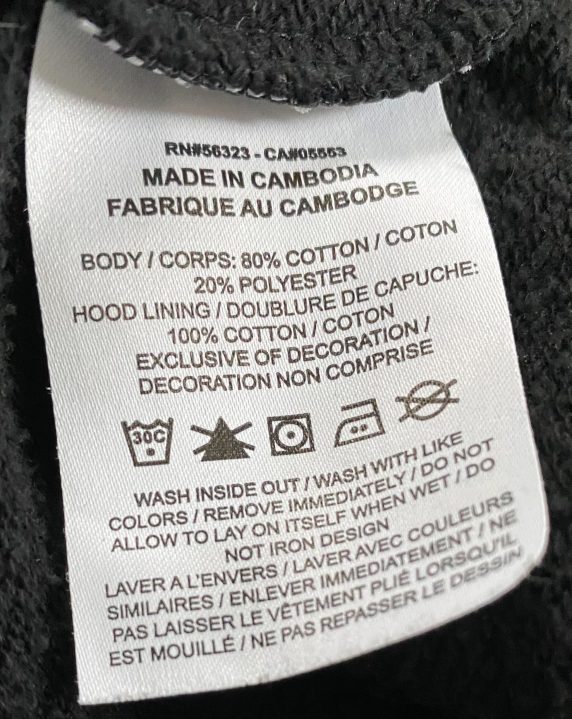Weird symbols on your T-shirt tag? Your iPhone can decipher them
(NEXSTAR) — When you buy a new piece of clothing, you’ll likely want it to last. And its lifespan will rely at least partially on how you care for it.
If you’re concerned about washing your clothes as intended, you’ve probably looked at the tag for guidance. If you were unlucky, you were met with a tag like this, found on a hooded sweatshirt from Taylor Swift’s The Eras Tour.

Unless you’re versed in the hieroglyphics of laundry care, those symbols may mean next to nothing to you. You’re not alone.
That’s where a bit of technology comes in. Sure, you could search the internet to decipher the language on the tag, but that’s like trying to ask Google about a song you can only vaguely remember.
Instead, as some on TikTok have found out, your iPhone can translate for you. All you have to do is take a picture of the tag.
This feature, offered on Apple devices, is called Visual Look Up. We previously told you about how you can use it to identify plants, landmarks, works of art, and books.
iPhone users have since found that it can help decipher clothing tags as well, as TikTok user @wtfaleisa pointed out in a video that has since amassed more than 3.3 million views.
Here’s how it works.
First, take a picture of the tag found on your shirt, sweater, jeans, or what have you. We’ll use the tag from The Eras Tour hoodie we mentioned before.
Then, open that picture in your Photos app. At the bottom of the screen, you should see what looks like a small washing machine or dryer in a circle, topped with a set of sparkles. You can see that in the photo below.
Once you tap on that icon, you’ll see a prompt to look up “Laundry Care.”
Here, you’ll see “Siri Knowledge” results breaking down the icons. Based on those results, our hooded sweatshirt should be washed in a “normal process,” with temperatures not exceeding 85 °F; bleach should not be used; and it can be ironed, but temperatures shouldn’t reach more than 230 °F.



We tried the Visual Look Up feature on a few other items, including a Nike hooded sweatshirt (which had the same guidelines, as well as “do not dry clean” and “tumble dry” with a max temperature of 140 °F) and a pair of Levi jeans (wash normally with temperatures not exceeding 85 °F; “tumble dry” with a max temperature of 140 °F; iron at temperatures less than 230 °F; and bleach only with non-chlorine agents). However, the CEO of Levi may have a different suggestion.


Why do we even use these symbols if they’re hard to understand?
They’re all part of a rule by the Federal Trade Commission that mandates manufacturers include care instructions on garments. This covers “textile apparel worn to cover or protect the body,” but there are some exceptions — shoes, gloves, and hats, as well as handkerchiefs, belts, suspenders, neckties, and “non-woven garments made for one-time use,” which are considered “excluded.”
That doesn’t mean you’ll never find a tag with laundry tips on these “excluded” items. We found the below tag on (or in?) a Carhartt beanie. You’ll notice it even explains what the icons mean.

There are some garments that don’t require a permanent care label, according to the FTC. That includes “products that may be washed, bleached, dried, ironed and dry cleaned by the harshest procedures available,” as long as “wash or dryclean, any normal method,” appears on a temporary label with the product.
The FTC explains that manufacturers and importers must also “provide warnings if the garment cannot be cleaned without harm.” So if your shirt would burn with the use of an iron, the tag must tell you that.
Manufacturers are allowed to use care symbols from the American Society for Testing and Materials (ASTM), which are the symbols your iPhone is reviewing. Those symbols can be used in place of words, like we saw on The Eras Tour hoodie. The FTC notes that these icons are similar but not identical to the International Standards Organization and used in many European countries.
There are five elements the FTC outlines that need to be on the tag: whether the item should be washed by hand or by machine; if it can be treated with bleach; how it should be dried; how it should be ironed; and if there is a “care procedure that will harm the product.” These can be specific depending on the item, like the maximum temperature for a wash cycle, or omitted, if that specific care element won’t harm the product. You may also find dry cleaning instructions on a tag.
The basic symbols you’ll see on a tag, seen here in this FTC handout, include a tub with water (washing instructions); a triangle (bleaching); a square, sometimes with a circle (drying); an iron, and a circle (dry cleaning).
Thankfully, you don’t need to memorize all these icons — you can ask your iPhone to identify them instead.









